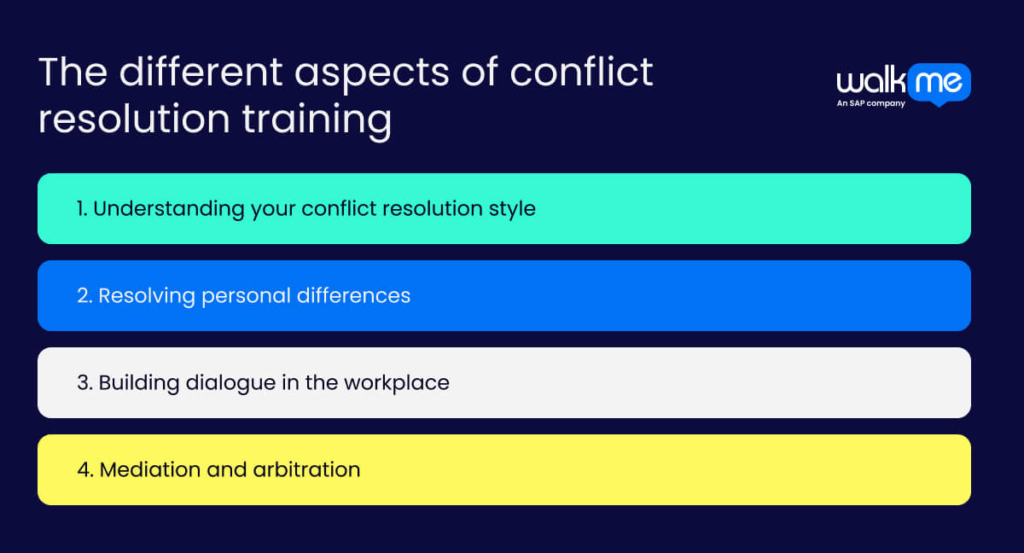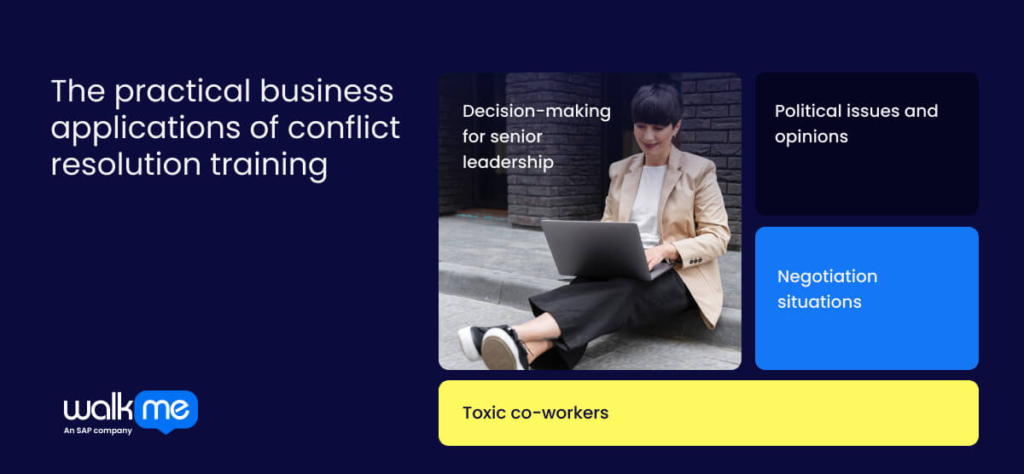Conflict brings out intense emotions like fear, anger, and pride, which can impact employee performance at all levels of an organization.
Even small conflicts—like negative feedback or differing opinions—can create significant challenges. Leaders can’t assume staff will resolve issues on their own.
Conflict resolution is a type of employee training that is essential for addressing these challenges. Effective conflict resolution training helps employees manage emotions, improve communication management, and find constructive solutions, leading to better teamwork and overall productivity.
This article will explore what conflict resolution training is, methods for implementing it, and situations where it is especially useful. By the end, you’ll understand how to approach conflict resolution training and improve your team’s ability to handle conflict effectively.
What is conflict resolution training?
Conflict resolution training teaches people how to manage and solve conflicts in a healthy way. Conflict can cause problems, like delays or people leaving their jobs, and soft skills alone aren’t always enough.
This training helps employees understand how conflict works, teaches strategies to handle it, and allows them to practice in real-life situations. Conflict resolution training is important for everyone, from executives to team members and customer-facing roles.
With this training, employees can deal with small issues before they grow into bigger problems, keeping the workplace running smoothly.
We will see in the next section how different types of conflict resolution training use these features differently.
The different aspects of conflict resolution training

This section will consider different aspects of learning and development in conflict management. In particular, we’ll think about:
- Understanding your conflict resolution style
- Resolving personal differences
- Building dialogue in the workplace
- Mediation and arbitration
A comprehensive training program might touch on these different aspects of conflict management. But often, you will facilitate piecemeal instruction for your staff members or leadership, in which case you’ll need to prioritize the most important features.
This kind of training will be especially valuable for staff in HR departments, but staff at all levels of the company can benefit from training in conflict management.
As we discuss these aspects of teaching conflict management, we’ll mention some methods of training that work. After all, resolving conflicts requires a balance of theoretical, practical, and emotional intelligence, which requires different pedagogical approaches to be successful.
Understanding your conflict management style
Understanding your conflict management style involves reflecting on your natural tendencies and preferences. It helps employees recognize their strengths and limitations.
This awareness is valuable in personal and professional contexts, enabling individuals to adapt their approach based on the nature of the conflict and the desired outcomes.
One of the most popular models of conflict management style is from Thomas and Kilmann, who explain that the main styles are:
- Collaborating
- Competing
- Compromising
- Accommodating
- Avoiding
All of these approaches have strengths and weaknesses. Effective conflict resolution training encourages individuals to understand their own styles and appreciate the diversity of styles within a team or organization, fostering a collaborative and constructive approach to conflict resolution.
How to implement
Understanding your conflict management style requires education and reflection. Any conflict management training program must give participants opportunities to think about their own experiences in relation to the theory of conflict styles.
Some of the prime training methods include:
- Encourage employees to maintain conflict resolution journals, reflecting on their experiences and strategies. This promotes self-reflection and deeper understanding.
- HR can create informal learning communities where employees at similar managerial levels share insights and experiences related to conflict management.
- The Thomas-Kilmann Conflict Mode Instrument is a useful tool for assessing conflict styles, though it requires an additional cost.
Tips and techniques for success
While you’re planning an intervention about conflict management styles, you could also think about the following pointers:
- Involve all employees: Help everyone understand their role in the conflict, not just executives.
- Use varied methods: Combine role-play and simulations to explore different conflict resolution styles.
Who is it for?
This training is for individuals looking to improve their conflict resolution skills, including employees, managers, and leaders. It helps participants identify their personal conflict management style, understand its impact on interactions, and learn strategies to handle disagreements more effectively, promoting healthier workplace relationships and communication.
Resolving personal differences
Personal differences may seem like a minor matter, but they can have a huge impact on employee well-being and team productivity.
Examples of this type of conflict can arise from any of the following issues:
- Values
- Beliefs
- Personality traits
- Work styles
- Interests
- Habits
- Perspectives
Participants in this type of training learn effective communication strategies, active listening, and techniques tailored to address disagreements, misunderstandings, and differing perspectives.
The goal is to empower individuals with the tools needed to foster healthier relationships, build understanding, and promote constructive dialogue in their personal lives.
How to implement
A good program for resolving personal differences should take a multi-pronged approach, engaging policy, leadership, and specific training sessions.
Some of the implementation strategies can include the following:
- Establish clear company guidelines on divisive issues and ensure line managers are fully briefed.
- Use these guidelines to conduct training on conflict resolution techniques, focusing on soft skills like listening, compromise, and empathy.
- Include cultural competence training to address personal differences from diverse backgrounds and promote inclusivity.
- Provide regular updates on the program, especially during key times like elections, holidays, or events, highlighting the need for continuous learning across the organization.
Tips and techniques for success
In this age of DEI culture, people are more willing than ever to resolve conflicts around personal differences. However, strategies in this area are also prone to challenges. Think about the following additional tips:
- Align actions with words: Ensure leaders support changes and that company practices match your messages about inclusivity.
- Monitor progress: Stay updated on trends and issues to address potential problems early.
- Invest in follow-up support: Ongoing mentoring and resources help reinforce conflict management principles.
Who is it for?
This training is for employees, managers, and leaders who want to improve their ability to resolve personal conflicts. It focuses on understanding and addressing interpersonal issues, promoting tolerance, inclusivity, and effective communication. Participants learn practical techniques to navigate differences and build stronger, more collaborative relationships in the workplace.
Building dialogue within a workplace
Supporting staff to build better dialogue enhances organizational culture. Effective dialogue promotes collaboration and helps mediate and prevent conflicts.
Unlike debates, where opposing sides compete, dialogue focuses on finding common ground. Training all staff in this area can lead to significant benefits, promoting understanding and improving workplace relationships.
How to implement
There are many ways you can train for better dialogue. These steps could help you get started:
- Provide staff with a framework for meaningful dialogue, emphasizing active listening, open communication, and the value of diverse perspectives.
- Define the role of a facilitator, clarifying their responsibilities and empowering them to guide discussions effectively.
- Set ground rules that promote respect and inclusivity, ensuring a safe space where all participants feel heard and engaged.
Tips and techniques for success
Facilitating dialogue can be difficult because it requires a lot of sensitivity to hard-to-spot human feelings and emotions. Think about these extra tips to make your dialogue training work better:
- Stay aware of biases: Facilitators must recognize and manage their own biases to keep discussions neutral and inclusive.
- Watch for signs of discomfort: Pay attention to non-verbal cues to ensure participants feel comfortable and respected.
- Use experiential learning: Participate in workshops, role-plays, and feedback sessions to build facilitation skills in a safe environment.
Who is it for?
This training is for employees, managers, and leaders aiming to enhance communication and foster open dialogue in the workplace. It focuses on creating a safe, inclusive discussion space, improving understanding, and resolving conflicts. Participants learn how to facilitate productive conversations, strengthen relationships, and promote collaboration.
Mediation and arbitration
Mediation and arbitration are specific types of conflict resolution characterized by the presence of a 3rd party facilitator.
Mediation is a voluntary and informal process in which a neutral third party, known as the mediator, assists disputing parties in reaching a mutually acceptable resolution. Arbitration is a more formal process in which an impartial third party, the arbitrator, hears arguments and evidence from each side and makes a binding decision to resolve the dispute.
Good training in this area requires attention to a lot of core skills, including:
- A wide range of soft skills
- Knowledge of the ethical implications
- Clarity around company policy
- An up-to-date understanding of relevant legal issues involved
Mediation and arbitration can, however, take a range of forms. A mediator must be a sensitive listener to settle minor disputes within a department.
How to implement it
Mediation and arbitration training is a niche specialism. If you believe your company would benefit from trained mediators, consider the following steps:
- Conduct a needs assessment to determine whether an in-house mediator is necessary or if outside help is more cost-effective for serious issues.
- Explore third-party consultancies offering ready-made programs, ranging from a few hours to a week, or create a comprehensive curriculum covering conflict analysis, communication, legal principles, and ethics.
- Incorporate practical exercises like case studies, role-playing, and simulations to help participants apply theoretical knowledge in real scenarios, enhancing retention and skill development.
Tips and techniques for success
There’s always room to improve on your mediation training strategy. Think about the following tips to build a successful program:
- Explore available resources: Use materials like CIPD’s reading list to help leaders understand mediation.
- Encourage continuous learning: Stay updated on legal changes and best practices, and motivate participants to keep improving their skills.
Who is it for?
This training is for leaders, HR professionals, and managers who want to develop skills in mediation and arbitration. It teaches methods to resolve disputes fairly and effectively, focusing on negotiation, conflict resolution techniques, and legal frameworks. Participants gain the tools to handle conflicts outside of traditional legal channels.
The practical business applications of conflict resolution training

In this section, we will take a closer look at four situations that can particularly benefit from lessons in conflict resolution. They are:
- Decision-making for senior leadership
- Political issues and opinions
- Negotiation situations
- Toxic co-workers
These areas show us how conflict resolution training can be valuable to any large company.
Decision-making for senior leadership
For senior leaders, conflict shouldn’t just be resolved—it should lead to better solutions. With differing opinions on strategy, experience, and delegation, conflict is inevitable. How a leader responds to their team in these situations is crucial. For more insights on leveraging conflict, Gartner’s Tina Nunno offers a unique perspective.
Political issues and opinions
According to Gartner’s Future of Work Trends Report 2025, inter-employee conflict is one of the key trends to manage. From our selection of conflict resolution training methods, you can particularly learn from techniques in building dialogue and resolving personal differences.
Experts in the field recognize that there are some simple but effective ways of improving training in this area.
Some approaches you can take include:
- Model inclusivity and listening
- Don’t avoid political discussions
- Establish ground rules and etiquette
- React with clarity to inappropriate comments
In the right organizational culture, such steps become clear on their own. However, additional training may help implement them and improve working life for everyone.
Negotiation situations
Small conflicts can have very serious consequences in high-stakes negotiations. A conflict that would be easy enough to manage if it were internal can become extremely costly.
Your company might take a serious financial hit when it is far easier to make amends on a personal level.
To train for this eventuality, consider adding some of the following strategies:
- Ensure conflict resolution training is included in your negotiating teams’ skillset. Address this proactively, not just when problems arise.
- Provide negotiators with advanced domain-specific knowledge through briefings. This helps identify issues early and resolve conflicts before they escalate.
- Analyze conflict dynamics, strategies, and outcomes using real-world case studies of past negotiations. This encourages critical thinking and helps negotiators understand different approaches to conflict resolution.
Toxic co-workers
Toxicity is subjective, but employees often know when certain managers consistently irritate others. It may not stem from personal values or material issues but from personalities, attitudes, and priorities that drag down the team. Training for this kind of conflict is tough, as toxicity is hard to spot and even harder to address.
Conflicts can confuse everyone, so it’s best to tackle these issues early. Challenging co-worker attitudes can lead to informal and formal complaints, making early resolution essential.
Training strategies to deal with this include:
- A team skilled in building dialogue and resolving personal conflicts will encounter fewer problems with toxic individuals. Open, non-confrontational communication helps teams make progress.
- Educating the team on the issue can be helpful. To anticipate situations, familiarize them with the “five jerks at work” (as Tessa Watt calls them).
- In challenging situations, a third-party mediator can be invaluable. While they do not need full mediation qualifications, understanding the process can be crucial in avoiding formal complaints.
Conflict will happen (so get ready to manage it)
Conflict in the workplace is, sadly, inevitable. Even with managers with the best intentions for their team, people will annoy, upset, and criticize one another.
That’s why conflict resolution training is so important. It’s unwise to trust that arguments will resolve themselves.
But if you’re at the start of your conflict resolution journey, remember that training is just one part of the jigsaw. The latest CIPD guide on conflict resolution and workplace bullying states the importance of early conflict resolution, with managers playing a crucial role in addressing disputes before they escalate.
Conflict resolution training is most useful when your business invests in its organizational culture from the ground up.

